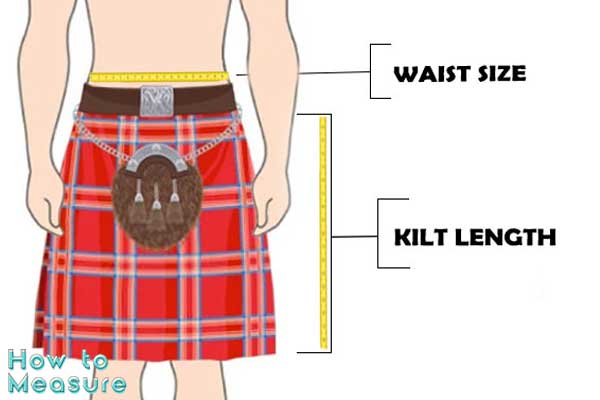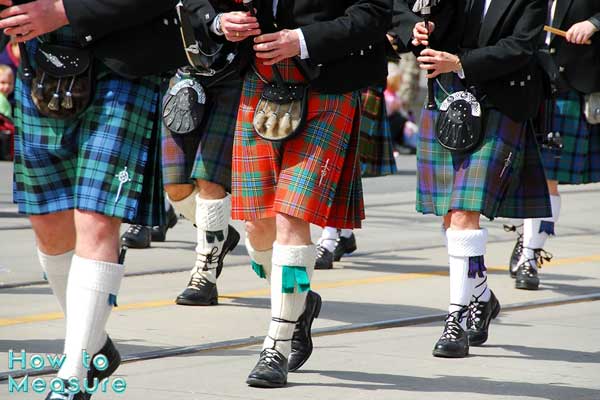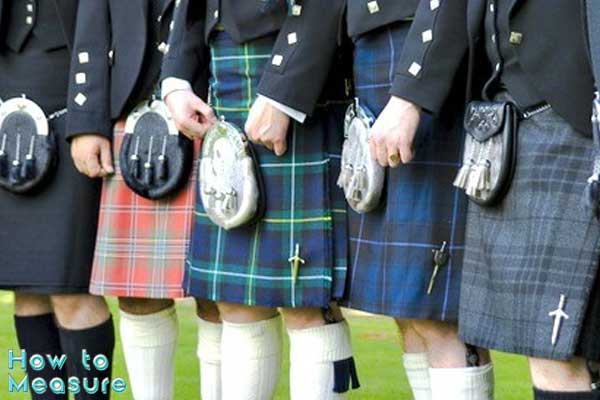The kilt, a traditional garment with a rich cultural heritage, has captivated people worldwide with its unique style and timeless elegance. Originating from the Scottish Highlands, the kilt is more than just a piece of clothing; it embodies history, tradition, and a sense of pride. Whether you’re a proud wearer of kilts or someone who appreciates their allure, understanding how to measure a kilt is crucial to ensure a perfect fit and an authentic experience.
This comprehensive guide on How to Measure will delve into measuring a kilt, demystifying the process, and providing you with the knowledge and tools necessary to achieve a flawless fit. Whether purchasing a kilt or creating a custom-made one, accurate measurements are the foundation of a well-fitting and comfortable garment.
Throughout this guide, we will explore the key measurements required, the proper techniques to obtain precise results, and valuable tips to consider while measuring. So, whether preparing for a special event, attending a Highland gathering, or simply adding a Scottish charm to your wardrobe, this guide will empower you to measure a kilt confidently and precisely.
But why is measuring a kilt so crucial? Well, a kilt that fits impeccably enhances your appearance and allows for ease of movement and comfort. By understanding the nuances of kilt measurements, you can ensure that the pleats are properly aligned, the waist sits at the right height, and the length falls at the ideal spot. Each measurement plays a crucial role in creating a kilt that looks fantastic and preserves this remarkable garment’s authenticity and essence.
So, whether you’re a seasoned kilt wearer or a newcomer to this fascinating attire, join us to unravel the secrets of measuring a kilt. Let us equip you with the knowledge and skills needed to embark on a fitting adventure that will undoubtedly enhance your appreciation for this iconic symbol of Scottish culture and enable you to enjoy the timeless charm of a perfectly fitted kilt.
What measurements do I need for a kilt?
To obtain a properly fitting kilt, several key measurements are needed. These measurements include:
- Waist Measurement: Measure around your waist at the desired rise point where you want the kilt to sit. Ensure the measuring tape is snug but tight enough.
- Hip Measurement: Wrap the measuring tape around the widest part of your hips. This measurement is crucial for ensuring the kilt fits comfortably and allows for ease of movement.
- Seat Measurement: Measure around the fullest part of your seat or buttocks. This measurement helps determine the appropriate amount of fabric needed for the back pleats of the kilt.
- Kilt Length Measurement: Decide on the desired length of your kilt, typically taken from the waist down to the desired hemline. This measurement can vary depending on personal preference, tradition, or occasion.
- Fell Measurement: The fell is the front apron of the kilt that overlaps when fastened. Measure from your desired rise point to where you want the kilt to end at the front. This measurement determines the length of the front apron.
- Waist to Hip Measurement: Measure from the waist to the fullest part of your hips. This measurement helps in determining the positioning of the kilt pleats.
It’s important to note that some kiltmakers or retailers may require additional measurements or have specific measurement guidelines. However, the abovementioned measurements are a foundation for obtaining a well-fitted kilt. Always refer to the specific instructions provided by the kiltmaker or retailer you are working with to ensure accuracy.
By taking these measurements with precision and care, you can confidently order a kilt that fits you perfectly, providing style and comfort for any occasion.
How to measure a kilt length?
Measuring the length of a kilt is an essential step to ensure it falls at the desired point on your legs. Here’s a step-by-step guide on how to measure kilt length:
- Stand up straight: Find a well-lit area and stand up straight with your feet shoulder-width apart. This allows for accurate measurements and ensures the kilt length is measured correctly.
- Decide on the desired kilt length: Determine how long your kilt will be. Traditionally, kilts are worn anywhere from the top of the kneecap to the middle. Your length depends on personal preference, tradition, and the occasion you’ll wear the kilt.
- Locate the rise point: Identify the desired rise point where you want the top of the kilt to sit on your waist. This is typically around the navel or slightly above it. Remember this point, as it will be used as a reference during the measurement.
- Measure from the rise point to the desired length: Using a measuring tape, start from the chosen rise point and let the tape fall straight down the front of your body. Measure the length you decided upon, such as the top or middle of the kneecap. Ensure the measuring tape is straight and not angled to obtain an accurate measurement.
- Repeat the measurement for accuracy: To ensure precision, take the measurement a couple of times, confirming consistency between each measurement. This helps minimize any errors and ensures an accurate kilt length.
By following these steps and taking precise measurements, you can determine the ideal length for your kilt, creating a balanced and aesthetically pleasing appearance. Remember to communicate the desired length to the kiltmaker or retailer when ordering or purchasing a kilt to ensure the finished garment meets your expectations.

How to measure the kilt waist?
Measuring the waist for a kilt is a crucial step in ensuring a proper fit. Here’s a step-by-step guide on how to measure the kilt waist accurately:
- Obtain a measuring tape: Use a flexible one, preferably designed for clothing measurements. It should be able to wrap around your waist comfortably.
- Determine the desired kilt rise: The rise refers to the height the kilt will sit on your waist. Traditionally, kilts are worn higher than modern trousers, typically at the navel or slightly above it. Decide where you want your kilt to sit, and remember that during the measurement process.
- Stand straight and relaxed: Maintain a natural posture with your feet shoulder-width apart. This allows for accurate measurements and ensures the kilt will fit comfortably.
- Locate the waist point: Find the point on your body where you want the top of the kilt to sit. This is usually the navel or the desired rise point mentioned earlier. Ensure the measuring tape is parallel to the ground for an accurate measurement.
- Wrap the measuring tape around your waist: Start by wrapping the measuring tape around your waist at the chosen rise point. Ensure the tape is snug but not too tight, allowing for a comfortable fit. Take note of the measurement in inches or centimeters.
- Repeat the measurement for accuracy: To ensure precision, it’s recommended to take the measurement twice or thrice, confirming consistency between measurements. This helps minimize any errors and ensures an accurate waist measurement.
Remember, when purchasing a kilt, it’s common to provide the waist measurement in inches or centimeters rather than using standard pant sizes. This measurement will be essential for determining the appropriate kilt size.
By following these steps and taking accurate waist measurements, you’ll be one step closer to acquiring a well-fitting kilt that exudes style and comfort.
What is the proper way to measure a kilt?
Measuring for a kilt requires attention to detail and following the proper steps to ensure accuracy. Here is a guide on the proper way to measure for a kilt:
- Gather the necessary tools: Grab a flexible measuring tape and a pen and paper to record your measurements. Using a measuring tape designed for clothing measurements is important as it will provide the most accurate results.
- Stand up straight: Stand in a natural and relaxed position with your feet slightly apart. Good posture is crucial for obtaining precise measurements.
- Determine the rise point: Decide where you want the top of the kilt to sit on your waist. Traditionally, kilts are worn higher than modern trousers, often around the navel or slightly above it. This is known as the rise point.
- Measure the waist: Wrap the measuring tape around your waist at the chosen rise point. Ensure the tape is snug but not too tight and parallel to the ground. Take note of the waist measurement in inches or centimeters.
- Measure the hip and seat: Wrap the measuring tape around the fullest part of your hips and record the measurement. Then, measure around the fullest part of your seat or buttocks. These measurements are essential for determining the appropriate size and fit of the kilt.
- Determine the kilt length: Decide on the desired length for your kilt. Measure from the chosen rise point to where you want the kilt to end on your legs. This measurement can vary based on personal preference and tradition.
- Additional measurements: Some kiltmakers or retailers may require additional measurements, such as the full measurement (the length of the front apron) or the waist-to-hip measurement (the distance between the waist and the fullest part of the hips). Be sure to follow any specific measurement guidelines provided by the kiltmaker or retailer you are working with.
- Double-check and record measurements: Repeat the measurements to ensure accuracy and consistency. Double-check all recorded measurements before communicating them to the kiltmaker or retailer.
Remember, it’s always a good idea to consult the specific measurement guidelines provided by the kiltmaker or retailer you are working with. They may have their instructions and preferences. By following the proper steps and taking precise measurements, you’ll acquire a well-fitting kilt that matches your style and comfort preferences.
Taking accurate kilt measurements at home
Taking accurate kilt measurements at home is possible with some care and attention. Here are some tips to help you measure your kilt accurately:
- Use a flexible measuring tape: Ensure you have a measuring tape that can easily bend and wrap around your body. This type of measuring tape is designed for clothing measurements and provides more precise results.
- Wear appropriate clothing: To get accurate measurements, wear thin and form-fitting clothing or measure directly on your skin. Avoid bulky or layered clothing that may affect the measurements.
- Stand in a natural position: Stand up straight with your feet shoulder-width apart. Keep your posture relaxed and natural throughout the measurement process.
- Take multiple measurements: To ensure accuracy, take each measurement two or three times and compare the results. Consistency between measurements will increase the reliability of your measurements.
- Use a mirror or ask for assistance: When measuring certain areas, like the seat or fell, use a mirror to help you position the measuring tape correctly. Alternatively, you can ask someone to assist you in taking the measurements to ensure accuracy.
- Measure with a snug but not a tight fit: When wrapping the measuring tape around your waist, hips, or seat, ensure it is snug against your body but not overly tight. This allows for a comfortable fit without distorting the measurements.
- Double-check measurement guidelines: Review any measurement guidelines they provide if purchasing a kilt from a specific kiltmaker or retailer. Follow their instructions carefully to ensure your measurements align with their requirements.
- Please keep track of measurements: Write down each measurement as you take them to avoid confusion or forgetting details. Label the measurements clearly, specifying which part of the body each measurement represents.
By following these tips and measuring accurately, you can gather the necessary measurements for your kilt. Remember, if you have any doubts or questions, don’t hesitate to contact the kiltmaker or retailer for guidance or clarification.

Kilt size and measurement chart
Here’s a size and measurement chart for a kilt:
| Size | Waist Measurement (inches) | Hip Measurement (inches) |
|---|---|---|
| S | 28-30 | 34-36 |
| M | 32-34 | 38-40 |
| L | 36-38 | 42-44 |
| XL | 40-42 | 46-48 |
| XXL | 44-46 | 50-52 |
Measurement Descriptions:
- Waist Measurement: The circumference of the waist at the desired rise point.
- Hip Measurement: The circumference of the fullest part of the hips.
- Kilt Length: The measurement from the rise point to the desired length on the legs.
Please note that the measurements in the chart are approximate and can vary depending on personal preference, kilt style, and specific kiltmaker or retailer guidelines. It’s essential to refer to their size charts or instructions for precise measurements.
When using the chart, find the appropriate size based on your waist and hip measurements. Then, choose the kilt length within the given range that aligns with your desired style and tradition. This chart is a general guideline and can vary between kiltmakers or retailers.
Remember to consult the guidelines provided by the kiltmaker or retailer you are working with. They may have their own size chart or measurement instructions that consider any unique considerations for their kilts.
Conclusion
In conclusion, measuring a kilt accurately ensures a perfect fit and an authentic wearing experience. By following the proper steps and paying attention to detail, you can obtain precise measurements that will contribute to your kilt’s overall comfort, style, and aesthetics.
Taking the time to measure your kilt waist, hips, seat, and length with care and accuracy is essential. Remember to stand in a natural position, use a flexible measuring tape, and take multiple measurements to ensure consistency. It’s also important to communicate your measurements clearly to the kiltmaker or retailer when ordering or purchasing a kilt.
By mastering the art of measuring a kilt, you can confidently embark on your journey of acquiring a well-fitted kilt that reflects your style, respects tradition, and allows you to embrace the allure of this remarkable garment.
Whether preparing for a special occasion, attending a Highland gathering, or adding a touch of Scottish charm to your wardrobe, the knowledge and skills you’ve gained from this guide will empower you to measure a kilt confidently and precisely.
Embrace the kilt’s heritage, elegance, and timeless appeal as you embark on your fitting adventure. Enjoy the satisfaction of wearing a kilt that looks fantastic and celebrates the authenticity and essence of this remarkable symbol of Scottish culture.











